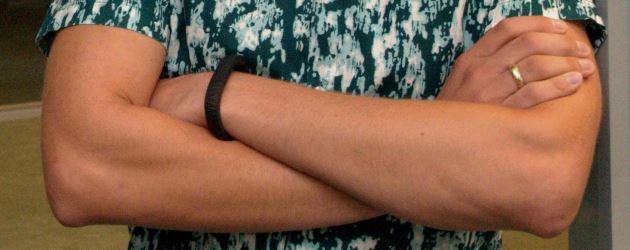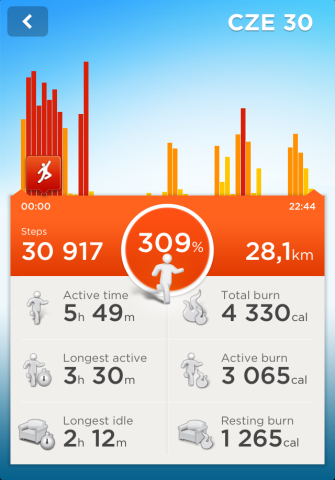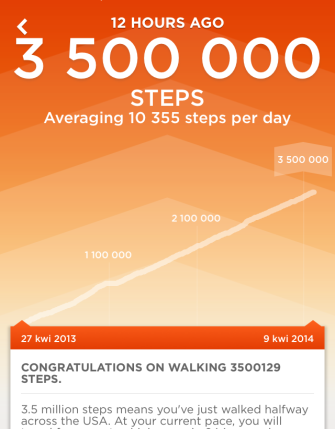On April 26, 2013 I activated my Jawbone UP and joined the Quantified Self crowd, following a favorable review by Eric Karjaluoto. I’ve been “living UP” for the past year - the most health-aware twelve months of my life - and while the band was an important part of it, today I wear it mostly out of habit.

Edit, June 2014: my Jawbone UP just died, after 14 months of continuous use. Symptoms point to a battery problem - the device seems to charge but always indicates an empty battery and quickly stops responding. Warranty lasts only 12 months, but Jawbone sent me a replacement nonetheless.
For a device worn 24/7, through heat waves, rains and blizzards, my Jawbone UP survived just fine. The manufacturer’s website claims I only need to take it off when swimming, which is exactly what I did. After a year it still looks good, collects data and delivers insights, although the on-device button is becoming increasingly unreliable.
Charging it takes an hour every 10 days, which is a negligible inconvenience. I only had a few times when it ran out of battery, and only due to negligence.
Movement
10,000 steps seemed daunting as a recommended goal at first, but I quickly realized that not only was I making this much on a regular day - I’d say it’s the bare minimum for a healthy adult. My daily routine involves walking from the subway station to the office for about 25 minutes, then back in the evening, plus walking out for lunch, which together with some office and home errands results in slightly more than 10,000 steps.
I thought that maybe UP wasn’t accurate, so I actually counted the steps I made on a section of my route, and the wristband’s report was on par with my number.
Reporting works well to the extent that movement of my left, UP-baring hand represents my activity. Walking is pretty correct. Biking shows nearly no movement, while a night of disco dancing (and I do tend to wave my hands a lot) reports slightly over 30,000 steps.

Sleeping
Jawbone UP seems accurate in measuring sleep too. It’s movement based, so I thought that sleeping with my wife might impact measurements, but the patterns looked similar on nights I slept alone, so the influence is probably not big. I cannot judge whether the “sound” and “light” (lately renamed from “deep” and “shallow”) sleep phases are being measured correctly though. Verifying it probably requires professional equipment.
Sleeping for the recommended minimum of 7 hours proved much more challenging than moving. I’m stuck at an average of about 6:40 and there’s simply too much interesting stuff to do during my waking hours, so I won’t be hitting the bed early any time soon.
UP also has a function to wake me up by vibrating when in light sleep phase, but being a happy owner of the Philips Wake-Up Light, I never tried this one out.
Eating
Keeping tracking of food consumption is perhaps the most cumbersome of UP’s features. It can’t be picked up automatically, so I had to enter everything by hand. There is the barcode scanner, which is great if you’re:
- eating a lot of packaged food, and
- live in the USA or UK, where the database of products is huge.
Being a slow food lover, living in Poland, I had to enter most freshly cooked meals ingredient by ingredient. I actually did that for a while - only as long as it took to get a feel of how much food was enough, too little or too much. Then I just stopped using this feature altogether.
Motivation
UP attempts to go beyond merely informing users of how they’re doing health-wise, but also tries to influence behavior change for the better. Of course, that’s really hard to achieve, because habits (including bad ones) by their very nature are deeply rooted in our personalities and extremely hard to evict. And while it’s pleasing to see some of my achievements:

overall the device fails to motivate. Maybe it’s me. Maybe I don’t have that much to improve upon. Or maybe the overall strategy is wrong.
“Team” is supposed to be your Facebook and Twitter friends using UP, sharing progress, accomplishments, and cheering each other on. I found just one, distant friend using UP, so no motivation here for me.
“Today I Will” looks more promising. Daily challenges from the device, like making 10% more steps, or going to bed 15 minutes early. Many of them will effectively work only with the newer UP24 model, which automatically sends all data to the smartphone app via Bluetooth. The manual sync-via-headphone-jack is too much of a hassle to track progress towards the goal during the day.
One feature I did find useful is vibrating when I remain idle for too long. I have a feeling it gets activated a bit too often, even if I do move moderately, but that’s not necessarily a bad thing. As a result I move more during the day, remember to get up from the computer, even if to fetch some water or briefly stroll around the office.
Other functions
Jawbone UP lets me enter my mood, which it then tries to correlate with movement, sleeping, eating, trying to figure out how these impact one another. It’s useless. I often end up setting my mood once a day and forgetting it later. At times when I am feeling down, it rarely is related to lack of sleep or movement - might be a quarrel I had with somebody or significant project hardship - things UP obviously isn’t able to pick up on.
What I miss most about the device is a powerful web interface. The iOS app is fine and continues to improve, but it’s very focused on the “now” and doesn’t let me inspect the broader data set. A web dashboard could give insight into longer trends, perhaps let me export data for even more extensive analysis. It’s a device for us - data nerds, and we sure know how to squeeze information out of raw digits. Opening up an API and letting hackers build their own analysis add-ons could spark a whole ecosystem!
The big picture
The last twelve months were a boon to wearables, with lots of press coverage, usage explosion and startups in the field popping up everywhere. Now the tide seems to be turning:
Last year we expected wearables market would be huge in 2014. But by April we already have abandoned 1 or 2. My wrist is gadget-free now too
— Tomomi Imura 🌺 (@girlie_mac) April 19, 2014
...reasons can be: lost. lost parts/charger. washed. broken. lost interest. bored. ugly. forgot to wear once and never bothered again. etc.
— Tomomi Imura 🌺 (@girlie_mac) April 19, 2014
I feel the same way. Over time UP lost the appeal of a cool gadget, and fulfilled its purpose by delivering the insights I was hoping for. There’s certainly more I could learn with a future update that would tackle some of today’s limitations. For now I’m contemplating abandoning it like more and more users do.
Manufacturers may already sense the trend, latest example being Nike firing some of the development staff behind its Fuel band. Low user loyalty will be a problem for those companies, that are now moving to monetize the data they’re collecting. I can already see them implementing Facebook-like tactics to “increase engagement,” that will further drive users away. On top of all that there’s also growing opposition from privacy advocates against making money off the always super-sensitively treated health-related data.
On the other hand we have government representatives who, late to the party as usual, seem to be discovering wearables just now. European Commission Vice-President Neelie Kroes praised the devices for increasing health awareness:
mHealth has a great potential to empower citizens to manage their own health and stay healthy longer, to trigger greater quality of care and comfort for patients, and to assist health professionals in their work. As such, exploring mHealth solutions can contribute to modern, efficient and sustainable health systems.
Neelie Kroes
What we - users see as fun gadgets, others see as aides in the everlasting struggle for better healthcare.
Personally, perhaps my single biggest take-away from the twelve months of wearing Jawbone UP is becoming much more health-aware, which led to attending gym regularly, better diet and visible improvements to both my fitness, and my looks. It’s been a very good year.